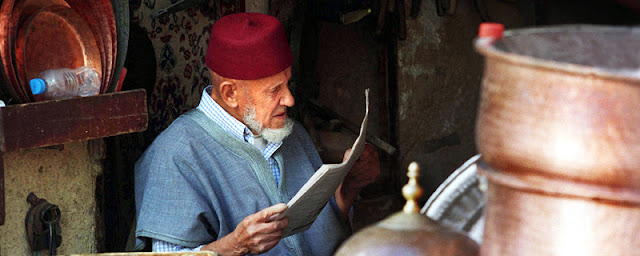Last night Dar Batha, a part of the French Institute here in Fez, was animated by Collectif 47's cinema/music project, "Les Mystères de l'Ouest." The piece, written for 9 musicians and "un écran géant," combined funky musical arrangements laced with innumerable textures and harmonies from across the (groovy parts of) the world and video, which was a narrative mashup of spliced Moroccan films and cartoons, mostly from the 1940s and 1950s. Our resident musicologist, Chris Witulski, reports...
Our story, a loose tale of a boy traveling west in search of freedom, began with a fingerpicked banjo/whistling take on everyone's favorite stock "Wild West" song, "The House of the Rising Sun." (If you need a tune to stick in your head, here's the classic by the Animals: (Link)
With clips of windy sand dunes draped from the video screen, the audience is lulled by elegant French poetic spoken verse, learning our hero's narrative. Within minutes, however, the vast empty space of the desert is replaced by writhing Brazilian carnival led, dixieland marching band tinged, Balkan wedding music. The sousaphone and surdo, a Brazilian bass drum used in the samba processions of Carnival, interject - and the evening refuses to settle down from that point on.
As we move from French to Moroccan Arabic, the subject changes. No longer is this the sweet poetry of French, but the abrupt and energetic start to our story. (The sweet poetry in Moroccan Arabic is there too, just a little bit later.) Dark harmonies between dark timbres of dark instruments float across grooves that coalesce between the funk beats of the drum set and the Arab dance rhythms of the darbouka. All this, of course, punctuated by that large Brazilian surdo.
 |
| Hajar Chargui |
Two singers, Ghassan El-Hakim and Hajar Chargui, gave very different edges to Singhkeo Panya's musical compositions and arrangements. El-Hakim's performances on the harder tunes (and his slam poetry-style hip hop recitation) contrasted perfectly with Chargui's beautiful throaty alto sound. Her range in both pitch and timbre brought both the "oriental" wisp to some tunes while she effectively summoned the Cairene Golden Age sound of performers like Um Kulthum in many others.
 |
| Ghassan El-Hakim |
The real center of attention, however, was how Panya's arranging animated the film. The songs carried simple lines through a depth of colors, all while effectively narrating the spliced romp through old black and white video, telling a story that was far more interesting than the tale of our boy hero. At one point, for example, in a segment entitled "Intersections," music reminiscent of Mingus at his best animated visuals of confused road signs and overactive, white gloved, Moroccan police officers directing traffic. Elsewhere, a 3- to 4- second clip of an old man making sfinj (fried donuts) was spliced into a dance of sorts that consumed the better part of a minute (a long time, considering the aggressively manic nature of the editing).
The project has been traveling across Morocco, with Fez as the penultimate stop. It will be in Tangier on Saturday (the 29th) at the French Institute. (Information) Those who are interested should be forewarned that there is no real interest in subtitles, but that ends up being mostly unimportant. There are a few bits of entertainment that come from the group's toying with language, however. For example, after a conversation between two of the musician/actors that rags on rural Moroccan Arabic, a subsequent segment is entitled "Les Pecheurs" in French and "The Fish of the Sea Are Free," a phrase from the dialogue, in Moroccan Arabic. Playful turns of language and rhyme abound in all three languages.
A short video of one song from this project, as performed during a previous visit to Dar Batha: (Link)
SHARE THIS!



No comments:
Post a Comment